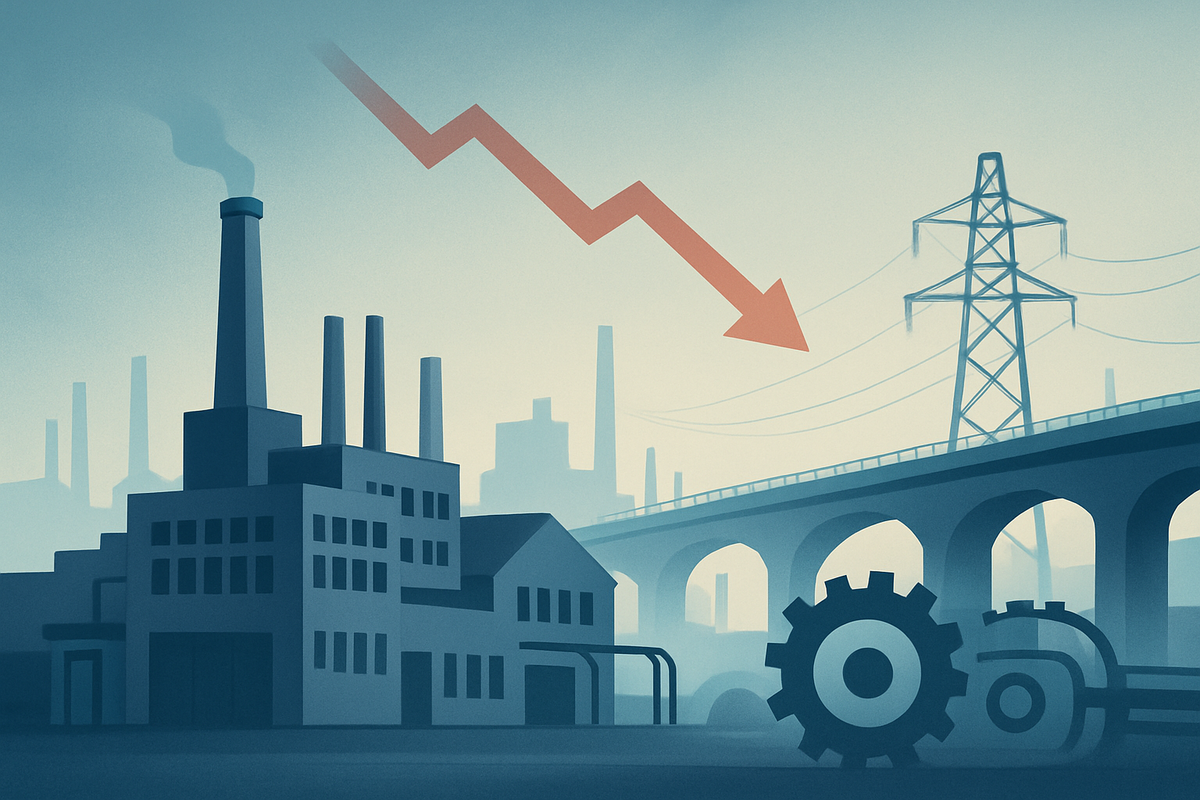
As the trading day concluded on October 29, 2025, the S&P 500 Industrials Sector found itself navigating a complex and somewhat subdued market landscape. While explicit, sector-wide performance highlights were scarce in today's news flow, the broader market sentiment, characterized by mixed conditions and a notable dip in the Dow Jones Industrial Average, cast a long shadow over industrial equities. This environment suggests a cautious approach from investors, with the sector's performance likely reflecting underlying concerns about economic momentum despite pockets of resilience elsewhere in the market.
The day's trading painted a picture of investor uncertainty, with various sectors experiencing divergent fortunes. However, the decline in the Dow, often seen as a bellwether for traditional industrial giants, signaled a particular headwind for the manufacturing, aerospace, and heavy equipment industries. This suggests that while some areas of the economy may be showing strength, the foundational industrial components are facing challenges, perhaps from rising input costs, softening demand, or tighter monetary conditions that impact large capital expenditure projects.
A Day of Caution: Unpacking the Market's Mixed Signals
Today's market activity, culminating in a noticeable fall for the Dow Jones Industrial Average, reflects a cautious stance from investors regarding the health of the industrial economy. While no specific, groundbreaking news emerged directly impacting the S&P 500 Industrials Sector as a whole, the broader market dynamics undoubtedly influenced its constituents. The Dow's performance, heavily weighted by companies like Caterpillar (NYSE: CAT), Boeing (NYSE: BA), and Honeywell (NASDAQ: HON), often serves as a proxy for the sentiment surrounding large-cap industrial players. A decline in this index typically indicates concerns over global trade, manufacturing output, or corporate spending on infrastructure and equipment.
The timeline of events leading up to this moment likely involves a confluence of macroeconomic factors. Persistent inflation concerns, evolving interest rate expectations, and geopolitical developments often create a volatile backdrop for industrials. These companies, with their extensive global supply chains and reliance on large-scale projects, are particularly sensitive to shifts in economic policy and international relations. Today's mixed market, therefore, could be a manifestation of investors processing a mosaic of economic data points, from manufacturing PMIs to consumer confidence reports, none of which might have offered a clear positive impetus for the industrial sector.
Key players and stakeholders involved include not just the industrial companies themselves, but also their extensive network of suppliers, customers, and the broader financial institutions that provide capital for their operations. Initial market reactions, inferred from the Dow's performance, suggest a collective decision by investors to de-risk or reallocate capital away from more cyclically sensitive industrial stocks. This doesn't necessarily imply a crisis but rather a period of re-evaluation in the face of prevailing economic uncertainties.
Industrial Giants at a Crossroads: Winners and Losers
In an environment where the Dow is falling and market conditions are mixed, the impact on individual industrial companies can vary significantly, creating both potential winners and losers within the S&P 500 Industrials Sector. Companies with strong balance sheets, diversified revenue streams, or those focused on resilient sub-sectors might weather the storm better. For instance, defense contractors like Lockheed Martin (NYSE: LMT) or Raytheon Technologies (NYSE: RTX) might see continued stability due to consistent government spending, potentially acting as defensive plays in a downturn, though even they are not immune to broader market sentiment.
Conversely, companies heavily reliant on capital expenditure cycles, large infrastructure projects, or international trade could face greater headwinds. Manufacturers of heavy machinery like Caterpillar (NYSE: CAT) or companies in the aerospace sector such as Boeing (NYSE: BA) are particularly sensitive to economic slowdowns, as businesses postpone investments and travel demand fluctuates. A falling Dow, signaling broader economic apprehension, directly translates to increased scrutiny on these companies' future order books and profitability.
Furthermore, companies with high debt levels or those struggling with supply chain inefficiencies could find themselves under increased pressure. Rising interest rates, if they are a contributing factor to the mixed market conditions, would exacerbate borrowing costs, impacting their ability to fund operations or expansion. Ultimately, the companies that demonstrate agility in adapting to changing demand patterns, optimizing their cost structures, and innovating in areas like automation or sustainable solutions are best positioned to navigate these challenging market dynamics.
Broader Implications: A Shifting Industrial Landscape
The current market conditions, characterized by a falling Dow and mixed sentiment, fit into broader industry trends that have been shaping the industrial sector for some time. We are seeing a continued push towards automation and digital transformation, driven by efficiency needs and labor shortages. Companies investing heavily in these areas, like Rockwell Automation (NYSE: ROK) or Siemens (ETR: SIE) (though primarily European, its trends influence global industrials), might find long-term advantages even if short-term market sentiment is negative. However, the immediate challenge is that economic uncertainty can delay such large-scale capital investments.
Potential ripple effects on competitors and partners are significant. If major industrial players experience a slowdown, it will inevitably impact their vast ecosystem of smaller suppliers and service providers. A contraction in orders from a giant like General Electric (NYSE: GE) or 3M (NYSE: MMM) can have cascading effects through their entire value chain. Conversely, companies offering cost-saving solutions or essential maintenance services might see relatively stable demand, as businesses prioritize operational efficiency during leaner times.
Regulatory and policy implications also play a crucial role. Government infrastructure spending initiatives, trade policies, and environmental regulations can either provide tailwinds or create headwinds for the sector. If the mixed market sentiment is partly due to uncertainty around future policy directions, industrial companies face an added layer of complexity in strategic planning. Historically, periods of economic uncertainty often lead to increased government intervention or stimulus packages, which could eventually benefit the sector, but the timing and nature of such interventions remain key unknowns.
What Comes Next: Navigating Uncertainty
Looking ahead, the S&P 500 Industrials Sector faces both short-term challenges and long-term opportunities in the wake of today's mixed market and the Dow's stumble. In the short term, investors should anticipate continued volatility as the market digests economic data and geopolitical developments. Companies may experience pressure on their earnings as demand softens and input costs remain elevated. This could lead to a conservative approach to capital allocation, with a focus on preserving cash and optimizing existing operations rather than aggressive expansion.
Long-term possibilities, however, suggest that the underlying demand for industrial products and services remains robust, driven by global urbanization, infrastructure needs, and the energy transition. Companies that can strategically pivot towards sustainable solutions, advanced manufacturing, and digital services are likely to emerge stronger. For instance, firms involved in renewable energy infrastructure or smart factory solutions might find growth opportunities even if traditional manufacturing faces headwinds.
Potential strategic pivots or adaptations required for industrial companies include greater supply chain resilience, a sharper focus on R&D for next-generation products, and exploring new markets. Market opportunities may emerge for companies with strong balance sheets to acquire struggling competitors or invest in innovative technologies at a lower cost. Challenges will include managing labor costs, navigating trade complexities, and adapting to evolving customer expectations for speed and customization. Potential scenarios range from a quick rebound if economic data improves unexpectedly to a prolonged period of modest growth if global economic uncertainties persist.
Wrapping Up: A Sector in Flux
Today's closing bell report for the S&P 500 Industrials Sector underscores a key takeaway: even without explicit sector-specific news, broader market conditions, particularly a falling Dow and mixed sentiment, significantly influence industrial equities. The sector, a cornerstone of the global economy, is highly sensitive to macroeconomic shifts, and today's trading day served as a reminder of its cyclical nature. While some companies may find defensive strength or niche growth, many are likely feeling the pinch of cautious investor sentiment and potential economic headwinds.
Moving forward, the market's assessment of the industrial sector will heavily depend on incoming economic data, particularly manufacturing indices, inflation figures, and interest rate decisions. Any signs of stabilization or improvement in global trade relations or infrastructure spending could provide a much-needed boost. Conversely, continued economic deceleration or policy uncertainty would likely prolong the current cautious environment.
Investors should watch for several key indicators in the coming months: corporate earnings reports from major industrial players, particularly their outlooks and guidance; government announcements regarding infrastructure projects or industrial policy; and global commodity price movements. The industrial sector remains a vital component of the market, and its trajectory will offer valuable insights into the broader economic landscape. The current period demands careful analysis and strategic positioning from both companies and investors alike.
This content is intended for informational purposes only and is not financial advice








